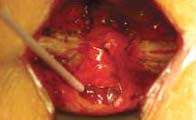New anti-adhesion gel could help make spine revision surgery easier
Investigators reported that a resorbable anti-adhesion gel was a promising option for spinal applications based on results of animal studies and early clinical use. They used it intraoperatively in the surgical area to coat the vessels or recesses in an attempt to prevent or lessen the postoperative formation of adhesions.
The proprietary gel they used was made of carboxymethylcellulose and polyethylene oxide (Oxiplex/SP, FzioMed Inc.). Oxiplex/SP and is indicated as an adjunct to lumbar laminectomy, laminotomy and discectomy procedures to reduce the extent and severity of postoperative adhesions and residual pain. The gel is available outside the United States through DePuy Spine (under the Oxiplex/SP brand) and Medtronic Sofamor Danek (under the MediShield brand). A randomized, blinded, multicenter pivotal clinical trial is nearing completion in the United States with expedited review status granted by the FDA.
Researchers at the Livingston Biology Laboratory, Keck School of Medicine, University of Southern California, Los Angeles, reported results using the Oxiplex/SP anti-adhesion barrier gel in a rabbit model. They studied the gel’s ability to prevent adhesions during a retroperitoneal approach — the kind used for artificial disc replacement surgery.
Prevention of adhesions in those situations could decrease the likelihood of damaging the great vessels during revision surgery, according to the researchers, who first presented their information at the 2005 Annual Congress of the Spine Society of Europe (EuroSpine 2005).
Less tenacious adhesions
Researchers operated on the spines of 10 rabbits, mobilizing the psoas muscles laterally and exposing the disc space. They then abraded the area to create surgical trauma. Five rabbits received no further treatment. Investigators coated the surgical area in the other animals with the gel.
At 28 days postop, researchers dissected the major blood vessels at the animals’ surgical sites to evaluate adhesion formation. They rated the adhesions in three regions of the vessels from 0 to 3, ranging from no adhesions to non-dissectible adhesions.
“Coating the vessels with Oxiplex/SP Gel after injury had a visible effect on the formation of adhesions,” the investigators wrote. All five control animals had extensive adhesions. In the treated group, tenacious adhesions on the vessels’ dorsal surfaces were reduced by 26%, and on the ventral surfaces they were reduced by 39%. This suggested that combining an anterior approach with the vessel-coating gel might make dissection easier during eventual revisions, they said.
|
Courtesy of FzioMed |
Clinical results
Such preclinical findings reflect the experience of neurosurgeon Patrick Fransen, MD, Clinique du parc Leopold, Brussels, who has used Oxiplex/SP gel in more than 300 lumbar spine surgeries.
He uses the gel systematically in disc herniation procedures, microdiscectomies and occasionally for short spinal stenosis.
Fransen only revised two or three patients whom he initially treated with the gel. “On these occasions, I found out that although there still were some adhesions, it was much easier to dissect the nerve from the surrounding tissues,” he said. “It took me less time do so and less manipulation of the nerve as well.”
Fransen typically uses a full 3-cc syringe of gel per case and a little less for microdiscectomies.
Publication of the U.S. pilot clinical trial (Neurosurgical Focus 17 (1): 2004) showed a reduction in leg pain and weakness in patients treated with Oxiplex/SP compared to a control group at one year after surgery.
Good surgery still required
There is no method for predicting which patients have a propensity for developing adhesions. Therefore, to be effective, preventative measures must be implemented routinely. “The only thing a surgeon can do is operate [as] cleanly as possible to avoid hemorrhage, to avoid infection, to rinse the operated site as much as possible, and to avoid any debris and leftovers of the disc that could create some irritation. If you do that, I think you do half the job. You lessen the chance of adhesions, but still some patients will develop adhesions. That’s where the gel comes in handy,” he told Orthopedics Today.
Fransen treated 62 patients with the former Gliatech anti-adhesion product, Adcon-L, and recently presented his comparative data (EANS, Luxembourg, Feb. 24-26, 2006). With Adcon, three patients developed skin reactions and two required reoperations for fluid collection around their wounds.
For more information:
- Berg RA, Rodgers K, Espinoza T, et al. Model development for prevention of perivascular adhesions in artificial disc surgery using Oxiplex/SP gel. #P45. Presented at EuroSpine 2005. Sept. 21-24, 2005. Barcelona, Spain.


